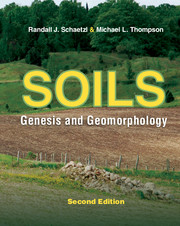9 - Weathering
Published online by Cambridge University Press: 12 January 2024
Summary
An important step in the formation of soil from rock involves weathering of the rock into smaller and/or chemically altered parts (Yatsu 1988). Weathering is the physical and chemical alteration of rocks and minerals at or near the Earth's surface, produced by biological, chemical, and physical agents (in actuality, by their combination), as they adjust toward an equilibrium state in the surface environment (Pope et al. 2002). Few soils form directly from bedrock. More often soils develop after an intermediate step in which weathering processes break rock down in situ, or geomorphic processes comminute and erode the rock. This intermediate step forms various types of regolith, or rock overburden, which are then acted upon by pedogenic processes to form soil (see Chapter 13). In the end, rocks become discolored, are structurally altered, acquire precipitates of weathering by-products, and experience collapse as a result of weathering. In this section we examine the main components and processes of weathering – a discussion that logically precedes our discussion of soil parent materials in Chapter 10. Excellent reviews of weathering are found in Ollier (1984), Yatsu (1988), Pope et al. (1995), Bland and Rolls (1998), and Hall et al. (2012).
In various degrees, rocks are physically and chemically unstable at the Earth's surface, and hence they weather, because the surficial environment is far different from the one in which they formed. For most rocks, the surface (soil) environment is colder, with less pressure and increased amounts of oxygen, water, and biota, than their formative environment, be it in a volcano's cooling magma, below the seafloor, or deep within the crust. For this reason, rocks, minerals, and soils are typically the most weathered at the surface and progressively less weathered with depth (April et al. 1986).
As noted in Chapter 4, primary minerals are those that crystallize as magma cools from high temperatures. Over long periods, primary minerals are unstable in soils and weather to secondary minerals, commonly clay minerals. In short, the essence of weathering is the breakup of rock and the formation of secondary minerals from the inherited (primary) minerals, as rocks are changed into forms that are more stable at the Earth's surface.
Several other processes are almost always associated with weathering, e.g., erosion (the wearing away of rocks or sediments/soils) and transport (the movement of those same materials), which collectively are termed denudation.
- Type
- Chapter
- Information
- SoilsGenesis and Geomorphology, pp. 165 - 180Publisher: Cambridge University PressPrint publication year: 2015

